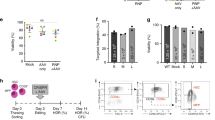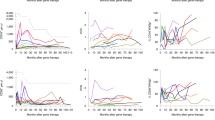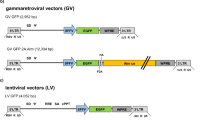Abstract
Boys affected with Wiskott–Aldrich syndrome (WAS) present with variable association of thrombocytopenia, eczema and immune deficiency. If untreated, WAS patients may succumb to intracerebral hemorrhages, severe infections or malignancies. Allogeneic bone marrow transplantation (BMT) can cure all aspects of the disease, but HLA-identical donors are not available to all patients and mismatched BMTs are unfortunately associated with high mortality and morbidity. The good success of HLA-matched BMT, however, makes WAS a potential candidate for hematopoietic stem cell gene therapy. WAS patients carry mutations of the Wiskott–Aldrich syndrome protein gene encoding WASP, a 502-amino acid proline-rich protein with demonstrated involvement in the organization of the actin cytoskeleton. To verify the feasibility of genetic correction for this disease, the WASP cDNA was expressed in EBV-immortalized B cell lines obtained from WAS patients using a retroviral vector. Transduced WAS cells showed levels of WASP expression similar to those found in cells from normal donors, without detectable effects on viability or growth characteristics. In addition, retrovirus-mediated expression of WASP led to improvement of cytoplasmic F-actin expression and formation of F-actin-positive microvilli, a process shown to be defective in untransduced WAS cell lines. These preliminary results indicate a potential use for retrovirus-mediated gene transfer as therapy for WAS.
This is a preview of subscription content, access via your institution
Access options
Subscribe to this journal
Receive 12 print issues and online access
$259.00 per year
only $21.58 per issue
Buy this article
- Purchase on Springer Link
- Instant access to full article PDF
Prices may be subject to local taxes which are calculated during checkout



Similar content being viewed by others
References
Sullivan KE, Mullen CA, Blaese RM, Winkelstein JA . A multiinstitutional survey of the Wiskott–Aldrich syndrome J Pediatr 1994 125: 876–885
Ochs HD . The Wiskott–Aldrich syndrome Springer Semin Immunopathol 1998 19: 435–458
Derry JM, Ochs HD, Francke U . Isolation of a novel gene mutated in Wiskott–Aldrich syndrome Cell 1994 78: 635–644
Villa A et al. X-linked thrombocytopenia and Wiskott–Aldrich syndrome are allelic diseases with mutations in the WASP gene Nat Genet 1995 9: 414–417
Stewart DM et al. Studies of the expression of the Wiskott–Aldrich syndrome protein J Clin Invest 1996 97: 2627–2634
Parolini O et al. Expression of Wiskott–Aldrich syndrome protein (WASP) gene during hematopoietic differentiation Blood 1997 90: 70–75
Aspenstrom P, Lindberg U, Hall A . Two GTPases, Cdc42 and Rac, bind directly to a protein implicated in the immunodeficiency disorder Wiskott–Aldrich syndrome Curr Biol 1996 6: 70–75
Symons M et al. Wiskott–Aldrich syndrome protein, a novel effector for the GTPase CDC42Hs, is implicated in actin polymerization Cell 1996 84: 723–734
Kolluri R et al. Direct interaction of the Wiskott Aldrich syndrome protein with the GTPase Cdc42 Proc Natl Acad Sci USA 1996 93: 5616–5618
Ramesh N, Anton IM, Hartwig JH, Geha RS . WIP, a protein associated with Wiskott–Aldrich syndrome protein, induces actin polymerization and redistribution in lymphoid cells Proc Natl Acad Sci USA 1997 94: 14671–14676
Brochstein JA et al. Marrow transplantation from human leukocyte antigen-identical or haploidentical donors for correction of Wiskott–Aldrich syndrome J Pediatr 1991 119: 907–912
Filipovich A . Stem cell transplantation from unrelated donors for correction of primary immunodeficiencies Immunol All Clin N Am 1996 16: 377–392
Miller AD et al. Construction and properties of retrovirus packaging cells based on gibbon ape leukemia virus J Virol 1991 65: 2220–2224
Treisman J et al. Interleukin-2-transduced lymphocytes grow in an autocrine fashion and remain responsive to antigen Blood 1995 85: 139–145
Bunnell BA et al. High-efficiency retrovirus-mediated gene transfer into human and nonhuman primate peripheral blood lymphocytes Proc Natl Acad Sci USA 1995 92: 7739–7743
Kenney D et al. Morphological abnormalities in the lymphocytes of patients with the Wiskott–Aldrich syndrome Blood 1986 68: 1329–1332
Gallego MD, Santamaria M, Pena J, Molina IJ . Defective actin reorganization and polymerization of Wiskott–Aldrich T cells in response to CD3-mediated stimulation Blood 1997 90: 3089–3097
Facchetti F et al. Defective actin polymerization in EBV-transformed B-cell lines from patients with the Wiskott–Aldrich syndrome J Pathol 1998 185: 99–107
Snapper SB et al. Wiskott–Aldrich syndrome protein-deficient mice reveal a role for WASP in T but not B cell activation Immunity 1998 9: 81–91
Huang MM et al. Expression of human Wiskott–Aldrich-syndrome protein in patients primary hematopoietic-cells and Ebv-transduced cell-lines after retroviral vector-mediated gene transduction Blood 1997 90: 1154
Fischer A et al. Bone marrow transplantation (BMT) in Europe for primary immunodeficiencies other than severe combined immunodeficiency: a report from the European Group for BMT and the European Group for Immunodeficiency Blood 1994 83: 1149–1154
Molina IJ et al. T cells of patients with the Wiskott–Aldrich syndrome have a restricted defect in proliferative responses J Immunol 1993 151: 4383–4390
Simon HU, Mills GB, Hashimoto S, Siminovitch KA . Evidence for defective transmembrane signaling in B cells from patients with Wiskott–Aldrich syndrome J Clin Invest 1992 90: 1396–1405
Henriquez NV, Rijkers GT, Zegers BJ . Antigen receptor-mediated transmembrane signaling in Wiskott–Aldrich syndrome J Immunol 1994 153: 395–399
Tiberghien P et al. Ganciclovir treatment of herpes simplex thymidine kinase-transduced primary T lymphocytes: an approach for specific in vivo donor T-cell depletion after bone marrow transplantation? Blood 1994 84: 1333–1341
Candotti F et al. Retroviral-mediated gene correction for X-linked severe combined immunodeficiency Blood 1996 87: 3097–3102
Acknowledgements
We are grateful to Dr S Weissman for donating the WASP cDNA and to Prof LD Notarangelo for insightful discussion and continuous support.
Author information
Authors and Affiliations
Rights and permissions
About this article
Cite this article
Candotti, F., Facchetti, F., Blanzuoli, L. et al. Retrovirus-mediated WASP gene transfer corrects defective actin polymerization in B cell lines from Wiskott–Aldrich syndrome patients carrying ‘null’ mutations. Gene Ther 6, 1170–1174 (1999). https://doi.org/10.1038/sj.gt.3300926
Received:
Accepted:
Published:
Issue Date:
DOI: https://doi.org/10.1038/sj.gt.3300926
Keywords
This article is cited by
-
Improvement of Migratory Defects in a Murine Model of Wiskott–Aldrich Syndrome Gene Therapy
Molecular Therapy (2008)
-
Lentiviral vectors targeting WASp expression to hematopoietic cells, efficiently transduce and correct cells from WAS patients
Gene Therapy (2007)
-
The Phenomenon of Spontaneous Genetic Reversions in the Wiskott-Aldrich Syndrome: A Report of the Workshop of the ESID Genetics Working Party at the XIIth Meeting of the European Society for Immunodeficiencies (ESID). Budapest, Hungary October 4–7, 2006
Journal of Clinical Immunology (2007)
-
A lentiviral vector encoding the human Wiskott–Aldrich syndrome protein corrects immune and cytoskeletal defects in WASP knockout mice
Gene Therapy (2005)
-
Functional correction of T cells derived from patients with the Wiskott–Aldrich syndrome (WAS) by transduction with an oncoretroviral vector encoding the WAS protein
Gene Therapy (2003)



